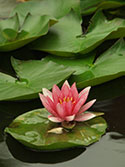Ayurvedic massage : origins
This massage is based on the principles of traditional Indian medicine, Ayurveda, which, in Sanskrit (sacred and literary language of ancient India) means:
"Science (Veda) of Life (Ayur)."
 The Ayurvedic Medical system is one of the oldest in the world. One of its more-renowned texts is the Charaka Samhita which indicates, amongother things, that a disease can not be cured unless the karma chain of causes and effects - that is said guarantee the order of the universe - is fully atoned.
The Ayurvedic Medical system is one of the oldest in the world. One of its more-renowned texts is the Charaka Samhita which indicates, amongother things, that a disease can not be cured unless the karma chain of causes and effects - that is said guarantee the order of the universe - is fully atoned.
In Hinduism, there are three types of karma:
• Prarabdha Karma, related to the birth and previous lives.
• Sarichita Karma, related to karma accumulated by the actions and thoughts today.
• Agama Karma, related to future actions.
According to Hindu mythology, this medicine was transmitted by the creator of the universe, the God Brahma who was born from a lotus.
It is usually depicted with four arms and four symbolic faces of the four veda (knowledge), four yugas (ages) and the four varna (class).
Ayurveda is based on a system with a comprehensive understanding of life's 'no attachments' definition, but with constant change. A rigid approach to this would be contrary to existence.
Dating back to over 3000 years ago, this medical system has evolved significantly in terms of lifestyle and bodily needs.
The Indian guru Maharishi Mahesh Yogi, introduced this knowledge to the West in the 1960s.
Needless to say, modern symptoms (such as intestinal problems, chronic fatigue, etc.) have been successfully treated with Ayurveda when Western medicine failed.
In the Vedic tradition, the science of pana (a vital energy for Hindus) connected to the soul is called Yoga and the one connected to the body is called Ayurveda.
- Origins | Practice | Benefits
